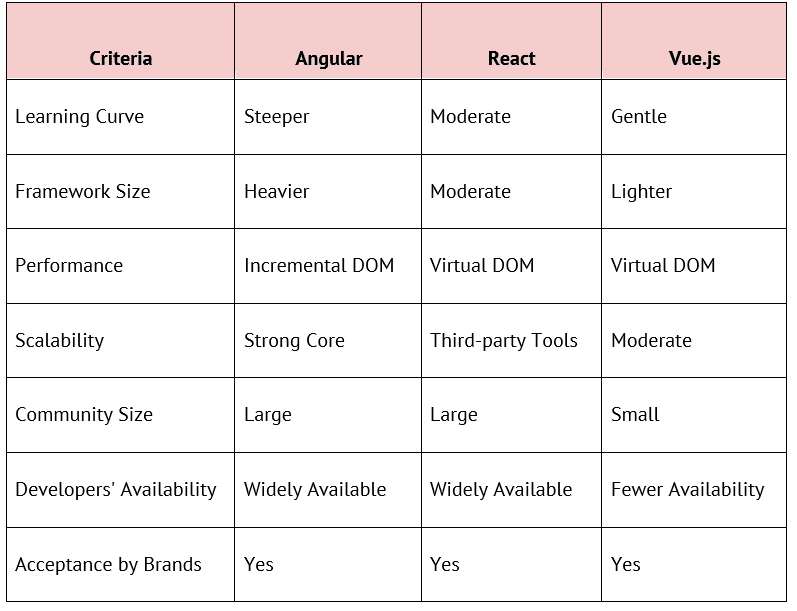Innovation occurs at an extraordinary rate in the rapidly changing technological world. Businesses have used a variety of tools and approaches over the years, some of which have been successful and long-lasting. JavaScript frameworks have evolved as strong stalwarts in this constantly shifting landscape, standing the test of time and becoming pioneers in the field of programming.
In a recent poll, over 65% of developers endorsed JavaScript as one of their favorite frameworks for development, highlighting the prevalence of JavaScript frameworks. This overwhelming endorsement highlights the crucial part these frameworks play in forming the modern digital environment.
The path of a JavaScript developer frequently involves a crucial choice: picking the best framework from the variety of possibilities as market options multiply. Three titans stand out in this selection conundrum: Angular, React, and Vue.js. Each of these frameworks has quickly risen to the top of the development field, carving itself a distinct niche.
Clarity is crucial when the curtain opens on the theater of options, though. In an effort to clarify the mysticism surrounding these frameworks, this post offers a useful road map for identifying the distinctive qualities of React, Angular, and Vue.js.
Understanding the Criteria
Choosing the right JavaScript framework necessitates a comprehensive evaluation of various factors. Here are key aspects to consider:
Understanding the Criteria
Choosing the right JavaScript framework necessitates a comprehensive evaluation of various factors. Here are key aspects to consider:
- Project Requirements: Make your selection based on the particular requirements of your project.
- Learning Curve: Take the framework and its related technologies’ complexity into consideration.
- Community and Support: Strong communities provide stronger support and ongoing growth.
- Performance: Rendering effectiveness and framework size both affect overall performance.
- Scalability: Take into account the framework’s capacity to support the development and growth of your application.
- Ecosystem and Third-Party Libraries: The accessibility of libraries can greatly affect the rate of development.
- Flexibility and Customization: Consider how well the framework fits the particular needs of your project.
What You Need To Know About Angular?
The full-featured framework Angular, created and maintained by Google, emphasizes TypeScript, a statically-typed superset of JavaScript. Since its introduction, Angular has undergone a great amount of development, including a full rewrite to increase its flexibility and conform to contemporary development standards.
Advantages of Angular
- Strong Dependency Injection: Angular’s dependency injection technology helps programmers create tested and maintainable code.
- Strong Tooling: Angular provides a full range of tools that simplify the development, testing, and deployment processes.
- Opinionated Architecture: The opinionated architecture of Angular enables modularization and a constant code structure.
Challenges of Angular
- Higher Learning Curve: The adoption of TypeScript and the complexity of the concepts both result in a higher learning curve.
- Bigger Bundle Sizes: The extensive capabilities of Angular may result in bigger bundle sizes, which might impair application performance.
- Constraints of Opinionated Architecture: The opinionated architecture might not meet all project needs.
Pros
- Model-View-ViewModel (MVVM) Architecture: Angular adheres to the MVVM architectural pattern, which improves code structure and the separation of concerns.
- Maintainability: The organized design of Angular makes its code more tenable, which makes managing and updating apps simpler.
- Web Application Development: Angular offers a wide range of tools and functionalities and excels at creating dynamic, feature-rich online apps.
- Support for Micro Front End Architectures: With Angular, developers can construct scalable, modular frontend components.
Cons
- Full HTML Tag Reload: When updates happen, Angular completely reloads HTML tags, which could have an impact on performance in some circumstances.
- Flexibility: Compared to more lightweight alternatives, Angular may appear rather stiff and inflexible due to its foundation in a full framework.
Ideal Use Cases for Angular
Angular is a fantastic choice for complex applications, real-time solutions like messaging apps, and tasks requiring a stable and scalable framework.
What You Need To Know About React?
Focusing on the creation of user interface components, Facebook was a leader in the development of the JavaScript package known as React. Incorporating JSX syntax makes it easier to distinguish UI components from JavaScript code.
Strengths of React
- Virtual DOM Optimization: React’s virtual DOM feature ensures selective updates to important components, which boosts efficiency. The algorithm behind the Virtual DOM is the Diffing algorithm.
- Predictable Data Flow: React implements a unidirectional data flow, guaranteeing consistent data handling and minimizing potential issues.
- Strong Ecosystem and Active Community: React offers a wide range of pre-made solutions and has a strong ecosystem and active community.
Challenges of React
- Learning curve for JSX concepts: JSX Concepts Have a Steep Learning Curve, it might be difficult for beginners to understand.
- Integrating Additional Libraries: To offer a complete solution, React frequently requires the integration of other libraries.
Pros
- Effective Data Loading: React’s effective rendering system guarantees prompt updates when new data is introduced, resulting in increased performance and a better user experience.
- Use of JSX: JSX, an enhanced syntax for JavaScript, enables developers to combine functionality and markup in a single file, improving the readability and structure of the code.
- Separating Data from display: A key component of React that promotes simplicity in the codebase and improves maintainability is the separation of data from display.
- Quick Start & Learning Curve: React is easy for developers to use right away and pick up rapidly because to its minimal setup requirements and straightforward concepts.
Ideal Use Cases for React
Single-page apps, modern business applications that are lightweight, and initiatives looking for a supportive community are all good candidates for React.
What You Need To Know About Vue?
- Vue.js, created by Evan You, is well recognized for emphasizing simplicity and versatility. It advertises itself as a progressive framework that lets developers absorb its features gradually.
Strengths of Vue.js
- Gentle Learning Curve: Vue is approachable for developers of all skill levels due to its straightforward syntax and progressive adoption of features.
- Simple Integration into Existing applications: The easy integration of Vue.js into existing applications facilitates migration.
- Detailed Documentation: Developers may better comprehend Vue’s functionalities thanks to its extensive documentation.
Challenges of Vue.js
- Smaller Community: The Vue community is much smaller than the communities for Angular and React.
- Limitations on Advanced Features: For really complicated projects, Vue can be missing some Advanced Features offered by Competitors.
Pros
- Rich Toolkit: To facilitate effective development, Vue.js provides a variety of tools and frameworks, including Vue Loader, Vue Router, and an official CLI.
- Flexibility and User-Friendly Syntax: Vue.js is noted for its flexibility and user-friendly syntax, making it approachable for both novice and expert developers.
- Vue.js has excellent documentation that offers a wealth of tools to help developers and shorten the learning curve.
- Reusability: Vue.js makes it easier to reuse code by using reactive components that are simple to incorporate into preexisting codebases.
Cons
- Smaller Community: Vue.js still has a smaller community than industry heavyweights like React and Angular, which may mean there are less third-party resources and solutions available.
- Plugin Accessibility: Compared to React and Angular, Vue.js has a smaller selection of plugins available.
Comparative Analysis
To facilitate a comparative understanding, let’s summarize the strengths and challenges of each framework across different criteria:
Considerations for Your Project
Matching your project requirements with the right framework involves considering several factors:
- Size and Complexity: Choose Angular for substantial and long-term investments, React for modern enterprise-grade apps, and Vue.js for fast MVPs or integration scenarios.
- Team Expertise: Leverage your team’s familiarity with a particular framework.
- Customization Needs: Select a framework aligning with the level of customization required by your project.
- Project Timeline: Opt for a framework that accelerates development based on your project’s timeline.
Winding Up
In conclusion, the choice between Angular, React, and Vue.js depends on your project’s unique characteristics and needs. Evaluating your project against the outlined criteria will guide you toward the most suitable framework. Ultimately, the right choice empowers you to create exceptional applications that meet your goals efficiently and effectively.





